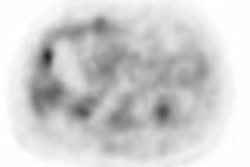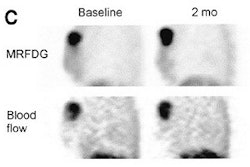Genetic research has shown that the presence of hypoxia in tumors can result in the over-expression of certain genes. One protein in particular, glucose transporter 1 (Glut-1), may be a potential predictor of malignant changes mediated by hypoxia (International Journal of Cancer, March 10, 2003, Vol. 104:1, pp. 85-91).
But what effect does the presence or absence of Glut-1 have on cancer imaging? A multidisciplinary group from Taiwan set out to answer this question with an investigation of FDG uptake in squamous cell carcinoma of the cervix (SCCC).
In this prospective study, Dr. Tzu-Chen Yen, Ph.D., and colleagues from Chang Gung Memorial Hospital, Chang Gung University looked at the association between Glut-1 and standardized uptake values (SUVs) obtained from FDG-PET scans. Yen is from the Taoyuan-based institution’s department of nuclear medicine. Yen's co-authors are from several other divisions, including gynecologic oncology, human genetics, radiology, and pathology.
"Theoretically, the more aggressive the tumor behavior, the more glucose is required for the increased (tumor) growth," the group wrote in the Journal of Nuclear Medicine. "In cervical cancer, (the absence of Glut-1) can predict an improved metastasis-free survival...the possible associations of Glut-1 expression with other clinicopathologic parameters and FDG-PET findings have not yet been elucidated in human cervical cancer," (January 2004, Vol. 45:1, pp. 22-29).
For this study, 51 patients with a histologic diagnosis of SCCC were included. FDG-PET scans were performed two weeks before surgery or CT-guided biopsy. After scanning, 51 histologically proven SCCC specimens from the 51 patients were examined for Glut-1 expression.
Patients were imaged on an ECAT EXACT HR+ scanner (CTI Molecular Imaging, Knoxville, TN; Siemens Medical Solutions, Malvern, PA) after a six-hour fast.
SUVs were determined by placing the regions of interest around the previously identified suspicious lesions. SUV1 was defined as "the SUV in the image acquired from 40-96 min after injection." SUV2 was defined as "the SUV from the later image (180-210 min after injection)."
When there were discrepant imaging findings between the three readers, CT and PET images were co-registered. Also, patients with indeterminate findings underwent intraoperative imaging with a PET probe.
Of the 51 patients, 25 had newly diagnosed cervical cancer while 26 had recurrent or persistent cervical cancer, or an unexplained elevation of tumor markers. Also, of the 51 cervical cancer specimens, 94.1% showed overexpression of Glut-1, the authors reported.
With regard to SUV1 and SUV2, both were highly and positively correlated for primary and recurrent tumor. In addition, a significant positive correlation was observed between SUVs and Glut-1 expression, they reported. Finally, a higher Glut-1 expression was associated with recurrent or persistent cervical cancer.
"Glut-1 overexpression in cervical cancer plays the main role in both its increased glucose uptake and energy utilization," they concluded. "The high 18F-FDG uptake in cervical cancer cells may occur through the mechanism of overexpression of Glut-1."
However, the authors cautioned against pinning all hopes on Glut-1 expression, as other glucose metabolism regulators could come into play. Increased hexokinase II enzyme activity, or the underexpression of G-6-Pase, may also be involved in FDG uptake.
Yen and co-authors plan to follow up these patients as they undergo therapy, and take note of outcome survival results.
By Shalmali PalAuntMinnie.com staff writer
February 17, 2004
Related Reading
Postmenopausal endogenous hormones influence endometrial cancer risk, February 5, 2004
Height and BMI in adolescence tied to ovarian cancer risk, August 20, 2003
Obesity may double risk of cervical adenocarcinoma, July 23, 2003
Chemotherapy tops radiation in endometrial cancer, but with high toxicity, June 4, 2003
Endometrial cancer can develop after radiation for cervical carcinoma, May 13, 2003
Copyright © 2004 AuntMinnie.com



















